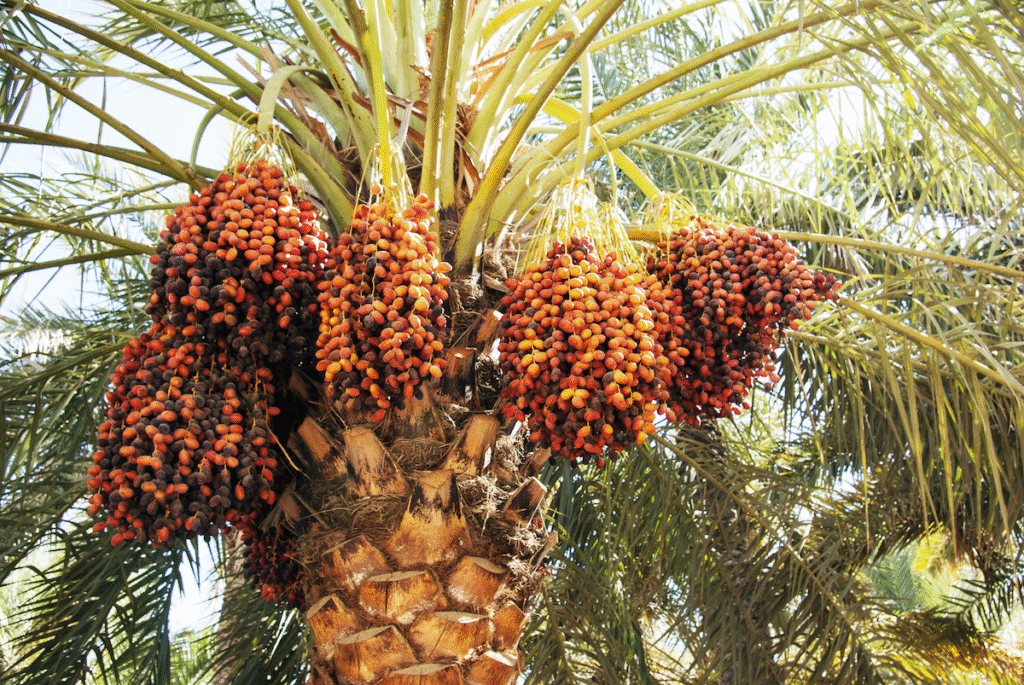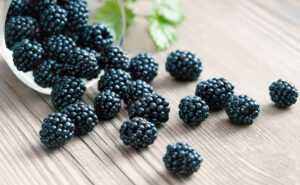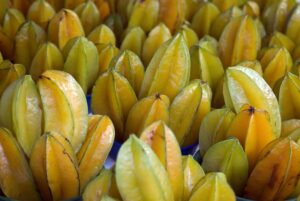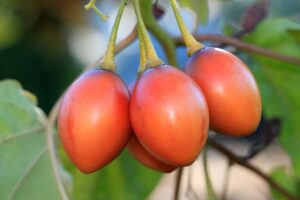How to Grow and Care for Dates: A Complete Guide
Growing date palms (Phoenix dactylifera) can be a rewarding experience whether you have a garden, patio space for containers, or even a sunny indoor spot. This comprehensive guide will walk you through everything you need to know about growing and caring for date palms from seed to harvest.
Understanding Date Palms
Date palms are ancient fruit-bearing trees that have been cultivated for thousands of years. These majestic plants can live for over 100 years and produce delicious, nutrient-rich fruits that have been a staple food in many cultures.

Types of Date Palms for Growing in the US
The US date industry is primarily concentrated in the hot, arid regions of California, Arizona, and Florida. The most common varieties grown commercially include:
| Variety | Fruit Characteristics | Climate Tolerance | Growth Rate | Space Requirements |
|---|---|---|---|---|
| Medjool | Large, soft, sweet | Zones 9-11, low humidity | Moderate | 20-25 ft spacing |
| Zahidi | Medium, semi-dry, mild | Zones 9-11, moderate humidity | Slow-moderate | 15-20 ft spacing |
| Deglet Noor | Medium, semi-dry, nutty | Zones 9-11, very low humidity | Moderate | 20 ft spacing |
| Barhi | Small-medium, very sweet | Zones 9-10, low humidity | Moderate | 18-20 ft spacing |
| Halawi | Medium, soft, caramel-like | Zones 9-11, low humidity | Moderate | 20 ft spacing |
Climate Considerations
Before starting your date palm journey, understand that these trees thrive in:
- Hot, dry climates (USDA zones 9-11)
- Full sun exposure
- Low humidity areas
- Regions with minimal rainfall
According to the USDA Agricultural Research Service, date palms require “at least 2,700 hours of sunshine annually and summer temperatures above 70°F” to produce quality fruit. You can verify climate requirements at the USDA Plant Hardiness Zone Map.
Growing Date Palms from Seed
Growing date palms from seed is economical but requires patience. Here’s how to do it:
Seed Selection and Preparation
- Obtain fresh date seeds from organic, unpasteurized dates
- Clean the seeds thoroughly to remove all fruit flesh
- Soak the seeds in warm water for 24-48 hours to soften the hard outer shell
- Optional: Lightly file one end of the seed to improve germination rate
Planting the Seeds
- Prepare a well-draining potting mix (2 parts sand, 1 part peat moss, 1 part perlite)
- Plant seeds horizontally 1-inch deep in individual containers
- Keep soil consistently moist but not soggy
- Maintain temperatures between 70-85°F (21-29°C)
- Place in bright, indirect light
- Expect germination in 2-8 weeks (sometimes longer)
Remember that seed-grown palms:
- May take 6-10 years to produce fruit
- May not produce fruit with the same qualities as the parent plant
- Are not guaranteed to be female (only female trees produce fruit)
Container Growing for Date Palms
Date palms can thrive in containers for several years, making them accessible to those without garden space.
Choosing the Right Container
For seedlings and young palms:
- Start with a 1-gallon pot for the first year
- Upgrade to a 5-gallon container in the second year
- Move to a 15-gallon or larger container as the palm matures
- Always use containers with drainage holes
Container Soil Mix
Create a well-draining mix:
- 40% coarse sand
- 30% peat moss or coco coir
- 20% perlite
- 10% compost
Care Requirements for Potted Date Palms
- Water thoroughly when the top 2 inches of soil feels dry
- Feed with a balanced palm fertilizer (8-8-8 or similar) every 2-3 months during growing season
- Position in full sun (minimum 6 hours daily)
- Protect from cold temperatures below 40°F (4°C)
- Repot every 2-3 years to refresh soil and provide more space
Growing Date Palms Outdoors
For those in suitable climates, growing date palms outdoors allows them to reach their full potential.
Site Selection
- Choose a location with full sun exposure
- Ensure good drainage
- Allow 20-30 feet between palms for mature growth
- Consider proximity to structures (mature palms can reach 50-80 feet)
- Plant away from power lines and buildings
Planting Process
- Dig a hole twice as wide and just as deep as the root ball
- Mix native soil with sand and compost (2:1:1 ratio)
- Plant at the same depth as the palm was previously growing
- Water thoroughly after planting
- Apply 2-3 inches of mulch around the base, keeping it away from the trunk
Ongoing Care for Date Palms

Watering Requirements
Date palms have evolved to thrive in arid conditions but still require proper irrigation:
- Young palms: Water deeply once weekly
- Established palms: Water deeply every 1-2 weeks
- Potted palms: Water when top 2 inches of soil are dry
- Reduce watering in winter months
The National Resource Conservation Service recommends “deep, infrequent watering rather than frequent, shallow irrigation” for optimal root development. For more information, visit the USDA NRCS Water Management resources.
Fertilization Schedule
Date palms benefit from regular feeding:
- Young palms: Apply balanced fertilizer (8-8-8) quarterly
- Mature palms: Apply specialized palm fertilizer 2-3 times yearly
- Container palms: Feed with half-strength solution every 6-8 weeks during growing season
- Always water thoroughly after fertilizing
Pruning and Maintenance
Unlike many fruit trees, date palms require minimal pruning:
- Remove dead or damaged fronds at the base
- Never cut healthy green fronds (they provide nutrients to the palm)
- Remove any unwanted offshoots (pups) from the base
- Trim flower stalks if not wanting fruit production
Common Pests and Diseases
Date palms are relatively resistant but can face challenges:
- Scale insects: Treat with horticultural oil or insecticidal soap
- Spider mites: Increase humidity and apply miticide if necessary
- Fungal issues: Improve air circulation and reduce overhead watering
- Nutrient deficiencies: Most common are manganese, potassium, and magnesium
Harvesting and Using Dates

When to Harvest
Date fruits develop in stages:
- Kimri stage: Green, hard, and inedible
- Khalal stage: Yellow or red, crunchy but edible
- Rutab stage: Partially brown and soft
- Tamar stage: Fully brown, soft, and sweet (ideal for harvesting)
Most home growers harvest dates at the Rutab or Tamar stage, typically 4-7 months after pollination.
Harvesting Methods
- Cut entire fruit clusters when dates begin to turn brown
- Hang clusters in a warm, dry location to finish ripening
- Alternative: Pick individual dates as they ripen on the tree
- Always use clean, sharp tools to avoid damaging the palm
Storing Your Harvest
Fresh dates can be:
- Refrigerated for up to 8 weeks
- Frozen for up to 12 months
- Dried for longer-term storage (up to 1 year at room temperature)
Culinary Uses for Dates
Your homegrown dates can be used in countless ways:
- Eaten fresh as a natural energy snack
- Chopped for salads and grain bowls
- Blended into smoothies and shakes
- Used as a natural sweetener in baking
- Stuffed with nuts or cheese for appetizers
- Made into date syrup or honey
Challenges for Home Growers
While rewarding, growing date palms does present challenges:
- Height: Mature palms can be difficult to pollinate and harvest
- Time to fruit: 4-8 years from planting (longer for seed-grown)
- Pollination: Separate male and female trees required for fruit
- Climate restrictions: Limited success outside of zones 9-11
For smaller spaces, consider dwarf varieties like ‘Pygmy Date Palm’ that reach only 10 feet in height.
Conclusion
Growing date palms can be a fascinating long-term project that connects you to one of humanity’s oldest cultivated foods. While commercial date production in the US market is centered in desert regions, home growers across many states can enjoy these magnificent plants as ornamentals or potential fruit producers with the right care and patience.
Whether you’re starting from seed, growing in containers, or planting directly in your garden, the journey of nurturing a date palm offers both challenges and rewards. By following the guidance in this article, you’ll be well-equipped to grow and care for these remarkable trees for years to come.






